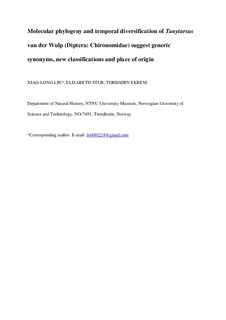| dc.contributor.author | Lin, Xiaolong | |
| dc.contributor.author | Stur, Elisabeth | |
| dc.contributor.author | Ekrem, Torbjørn | |
| dc.date.accessioned | 2018-05-08T07:57:13Z | |
| dc.date.available | 2018-05-08T07:57:13Z | |
| dc.date.created | 2018-04-03T10:51:07Z | |
| dc.date.issued | 2018 | |
| dc.identifier.citation | Systematic Entomology. 2018. | nb_NO |
| dc.identifier.issn | 0307-6970 | |
| dc.identifier.uri | http://hdl.handle.net/11250/2497473 | |
| dc.description.abstract | Tanytarsus van der Wulp, with 355 currently known valid species, is a comparatively large genus of nonbiting midges (Diptera: Chironomidae). Relationships among Tanytarsus and associated genera and among species in the genus have been exceptionally difficult to resolve using morphology or single gene genealogies. Here, the phylogeny of Tanytarsus sensu lato is reconstructed based on the combined analysis of five nuclear markers, including both ribosomal (18S) and protein‐coding (AATS1, CAD, PGD and TPI) genes. Our results indicate that Tanytarsus is paraphyletic with Caladomyia Säwedal placed among South American Tanytarsus, Virgatanytarsus Pinder as part of a Gondwanan clade, and Corynocera Zetterstedt within the Tanytarsus norvegicus (Kieffer) species group. Based on these results, we synonymize Caladomyia and Virgatanytarsus with Tanytarsus. We propose retaining the older name Corynocera until an eventual International Code of Zoological Nomenclature ruling on precedence can be made regarding the more frequent usage of the younger name Tanytarsus. As expected, the previously synonymized Nimbocera Reiss is confirmed to be a junior synonym of Tanytarsus with T. rhabdomantis (Trivinho‐Strixino & Strixino) grouping with other Neotropical Tanytarsus. The genus Sublettea Roback remains valid outside of Tanytarsus + Cladotanytarsus Kieffer. The monophyly of some established species groups is well supported, while other groups are refuted or remain uncertain. Based on a calibrated molecular divergence time analysis, Tanytarsus diverged from its sister group Cladotanytarsus during the Late Cretaceous to Early Paleogene (61–79 Ma). The genus most likely originated in the Oriental and Palearctic regions. | nb_NO |
| dc.language.iso | eng | nb_NO |
| dc.publisher | Wiley | nb_NO |
| dc.relation.uri | https://onlinelibrary.wiley.com/doi/full/10.1111/syen.12292 | |
| dc.title | Molecular phylogeny and temporal diversification of Tanytarsus van der Wulp (Diptera: Chironomidae) support generic synonymies, a new classification and centre of origin | nb_NO |
| dc.type | Journal article | nb_NO |
| dc.type | Peer reviewed | nb_NO |
| dc.description.version | acceptedVersion | nb_NO |
| dc.source.pagenumber | 19 | nb_NO |
| dc.source.journal | Systematic Entomology | nb_NO |
| dc.identifier.doi | 10.1111/syen.12292 | |
| dc.identifier.cristin | 1576706 | |
| dc.description.localcode | © 2018 The Royal Entomological Society. This is the peer reviewed version of the article, LOCKED until 30 March 2019 due to copyright restrictions. The article has been published in final form at https://onlinelibrary.wiley.com/doi/abs/10.1111/syen.12292. This article may be used for non-commercial purposes in accordance with Wiley Terms and Conditions for Self-Archiving. | nb_NO |
| cristin.unitcode | 194,31,10,0 | |
| cristin.unitname | Institutt for naturhistorie | |
| cristin.ispublished | true | |
| cristin.fulltext | postprint | |
| cristin.qualitycode | 1 | |
